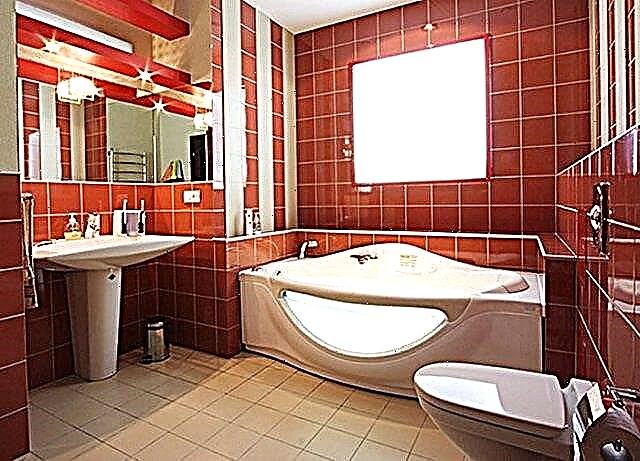For many years, ceramic tile has been the undisputed leader among all the finishing materials for the toilet and bathroom. Almost unlimited, modern selection of ceramic products makes it possible not only to satisfy the most sophisticated tastes, but also to design a room in any color scheme and style.
The advantages of such a finish are immediately visible:
- the tile is easy to clean,
- does not require any antibacterial treatment,
- the tile is very environmentally friendly
- not afraid of temperature extremes and high humidity.
- It is an excellent electrical insulating material, so it can be completely safely used in the bathroom.
Nowadays, in the assortment of finishing materials for the toilet and bathroom, there are a huge number of options for tiles for a variety of purposes and premises, different textures and colors, but there is no universal type of tile that could fit in absolutely all respects. Any kind of tile, regardless of what material it was made of, gives unlimited scope for imagination and the ability to solve non-standard and unusual style tasks.
When choosing ceramic tiles, you need to have at least a little idea about the features of this finishing material, so as not to make any mistake that could result in the resumption of repairs. The most basic selection criteria that must be taken into account when choosing a tile for a toilet or bathroom are the place of application, technical functions and features, as well as the design and quality of the product.
Quality
Any material that is used to decorate a toilet or bathroom must be safe, practical and resistant to the effects of active chemicals. In order for the facing surface to serve for a long time and not lose its characteristics and properties, during the selection you need to pay attention to the quality of the tiles for the bathroom. For the correct assessment of a particular type of material, you need to know the basic quality criteria:
- there should not be any spots and discolourations on the surface of the tile,
- there should be no bulges, cracks or roughness on the front side. To check, you just need to fold the two tiles with the front sides: in this case, there should not be any gaps between them,
- the side faces of the tile should be flat. Checking this is also very easy, you just need to connect the two tiles with the side faces and examine the joint: the gap should be less than half a millimeter, and there should be no clearance at all on the tile, which is designed for laying by a seamless method,
- on the back side of chips and cracks should not be. It should be noted that the embossed surface of the rear side of the tile will be an additional plus, as this provides greater adhesion to the lower layer.
In many ways, the quality of a tile is determined by its grade. To date, there are three varieties of tiles. Unfortunately, they are not always indicated on the packaging. However, a grade can always be identified by the color of the ceramic tiles: the designations on the first grade are marked in red, the second on blue, and the third on green.
Specifications
You need to distinguish between concepts such as “technical characteristics of tiles” and “quality of tiles”, otherwise you risk losing your money in vain. Agree, it is not necessary to lay the floor of the bathroom or toilet with tiles with sufficiently high frost resistance or with very high wear resistance. Typically, such floor tiles are laid in public areas where large crowds are very frequent.
When planning to use the tiles in the kitchen, in the bathroom or toilet, it should be remembered that the floor and walls of these rooms are exposed to various chemicals, such as cosmetics, detergents and cleaners, which include aggressive components and substances, as well as various kinds of household chemicals . As a result, spots can appear on the surfaces of the floor and walls, which, in some cases, are quite difficult to get rid of. In order to avoid this, it is possible to use tiles for facing, which has high acid resistance and low porosity. Such tiles over time do not lose their properties and characteristics, do not fade, retain their brightness and luster.
When choosing ceramic tiles, be sure to pay attention to the marking, since floor tiles are quite different from wall tiles in their properties and characteristics. Ceramic tiles designed for wall decoration can look the same as floor tiles, but at the same time it will be completely unsuitable for flooring, as it has less wear resistance and is very slippery. Tiles that are designed for walls are usually indicated by the “hand” icon, and the floor is indicated by the “foot on a black background” icon. If the foot is not on a black background, but on a shaded one, then this indicates increased wear resistance of the tile. In the event that two pictograms are indicated on the package, this indicates an increased quality of the product.
It should be remembered that the optimal thickness of the floor tiles is 9-12 millimeters, and the product must necessarily be first grade. The thickness of the wall ceramic tiles can be about 6-10 millimeters. In addition, you need to consider the size of the room, because the larger it is, the larger the tiles you need for decoration, so that the floor and walls look harmonious and aesthetically pleasing.
In addition, special characters will also help verify the technical and material properties. The symbol "AA" means that the tile is quite resistant to chemicals, and the symbol "A" shows less resistance. The tile with the marking "O" has a low resistance, intermediate - with the marking "B" or "C".
Design
Over time, the usual design of a kitchen, toilet or bathroom may get bored. In addition, time goes on, fashion changes, new, quite interesting color combinations appear, decor options and drawings. Fortunately, a modern range of ceramic products offers ample opportunities for experimentation. Designers can now play in contrasting colors, visually increasing or decreasing the space, rotate the tile by a certain number of degrees, or simply zoning the room using various products. Ceramic tiles called "Chameleon" with very noticeable tints, abstract ornaments, stylized flowers and an ethnic theme in the design - the choice is huge, it remains only to select the right product that will meet the quality criteria and possess the necessary technical characteristics.
Very often, a collection of ceramic tiles is already selected according to texture and color, and includes a set of floor and wall tiles, decor elements and borders, which greatly simplifies the selection process and saves money and time. It is very important to remember that even if ceramic tiles are selected in the same color scheme, but not from the same collection, you need to carefully study the characteristics of the product. At different companies, tiles can vary in thickness and size. Of course, the use of such materials on one surface is unacceptable, especially in large rooms.
Tile Laying Principles
1. Classic
This style is considered the oldest and most basic, but it is widely used now. Its meaning is to divide the walls of the bathroom into two parts. In the lower part, as a rule, darker tiles are laid, and the upper part of the wall is faced with lighter tiles. To achieve the original solution, special inserts with ornaments are used, which are placed in a separate strip between two colors.

2. Geometric
This style is more modern. As a rule, it is used by more creative designers with a non-standard approach to their business. This design of laying tiles in the bathroom has a fairly modern appearance.

3. Imitation
But tile manufacturing technologies do not stand still and, developing, gave the consumer the opportunity to lay out either various bas-reliefs or “brick racks” in the bathroom.
4. Ethno
Using this style, designers achieve a stay in different ethnic countries. Choosing tiles, you can get tropical trees or the effect of a primitive cave in your bathroom. This type of design is suitable for lovers of more unconventional approaches.

The design of laying tiles in the bathroom is affected by:
1. Quality
Inspect the tile carefully during delivery. All packs must belong to the same batch. Otherwise, you risk visually getting one tile color, but different in color. After that, it is worth paying attention to the manufacture of tiles. The surface should not have scratches and glitches.

2. The front surface
Since the bathroom is one of the most moisture-resistant places, it is clear that moisture on the tile itself is inevitable. But in addition to water, various hygiene products, cleaning products also get on the tile. Therefore, the wall tiles in the bathroom should be as smooth as possible and have high resistance to various acids.
3. Floor tiles
The most that you need to understand when choosing floor tiles for the bathroom is that you will have to walk on the tiles with wet feet. This means that if the tiles on the floor are glossy, then you risk slipping and injuring yourself. Therefore, the tile must have an anti-skid effect.

4. Number of tiles
In order to change the design of the bathroom quickly and without problems, you must immediately clearly calculate the number of tiles. As a rule, another 10-15% is added to the calculated coverage area. But this number is very strongly influenced by the way of laying itself, as well as the design of the tile itself. If the tile has a pattern, then you need to add the number of tiles. Well, the last thing that affects these numbers is the professionalism of the master. Because the volume of spoiled material and waste depends on how it carefully cuts the tile.
5. Tile color
When choosing a color and tile design, you should remember one rule: if you use light colors when choosing a tile laying design, you visually expand the area of the bathroom. Do not forget that you can overdo it with flowers. This means that it is not recommended to combine more than three different colors for the bathroom.

6. Moisture resistance and purpose of a tile
Since, as already mentioned above, the humidity in the bathroom is an order of magnitude higher than in other places in the living room, the tile should also have high moisture resistance. And most importantly, it is worth remembering: if the tile indicates that it is intended for laying on the wall, then do not experiment and lay it on the floor. In this case, the tile will quickly begin to distort and soon cracks and chips will appear on it.



